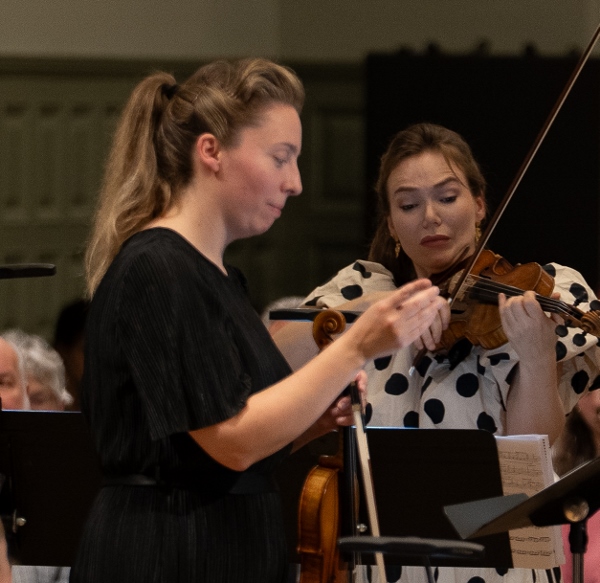Waley-Cohen, Manchester Camerata, Pether, Whitworth Art Gallery, Manchester review - premiere of no ordinary violin concerto | reviews, news & interviews
Waley-Cohen, Manchester Camerata, Pether, Whitworth Art Gallery, Manchester review - premiere of no ordinary violin concerto
Waley-Cohen, Manchester Camerata, Pether, Whitworth Art Gallery, Manchester review - premiere of no ordinary violin concerto
Images of maternal care inspired by Hepworth and played in a gallery setting

Manchester Camerata is enhancing its reputation for pioneering with three performances featuring Nick Martin’s new Violin Concerto, which it has commissioned, two of them in art galleries rather than conventional music venues.
So the concerto had its world premiere in The Whitworth, Manchester’s university-linked gallery, with the second performance at The Hepworth in Huddersfield. There’s a reason for that: Martin has taken his inspiration from “a carved torso-sized, cradle-like form, in elm, with nine strings of fishing line” by Barbara Hepworth: it’s called Landscape Sculpture.
In it (as he explained before the performances – I heard the first of two on the the same evening in Manchester) he sees images of a cradle, a boat and a stringed instrument, and the idea of mother and child gave rise to the kind of relationship he’s created between soloist and orchestra in this work.
It’s no ordinary concerto: there’s almost no overt display for the solo violin, indeed its role is at times almost subservient to that of the orchestra and its component parts. It’s scored for flutes, oboe, cor anglais, horns and strings, and, though constructed in three movements, it has a quality of serenity and uses mainly slowly moving, sustained textures that permeate all three (and the second segued into the third almost imperceptibly), making up a work that seems almost trance-like over its near-40-minute span.
 It was given a focused and carefully blended initiation, and his objective of capturing the feelings of care and trust shared by a mother and a child was fully realized by the Camerata, with Tamsin Waley-Cohen as the often self-effacing but also warmly expressive soloist, and Caroline Pether (pictured) presiding from the score to ensure smooth, neat entries and sustain the music’s flow amid many subtle tempo changes – and occasionally resuming her familiar role as leader/director of the ensemble at the same time. Martin’s style is often of slowly-built accumulations of textures, fundamentally tonal (though with some pitch-bending at the outset) and to me reminiscent of some of the similarly passionate and meditative writing of Peteris Vasks.
It was given a focused and carefully blended initiation, and his objective of capturing the feelings of care and trust shared by a mother and a child was fully realized by the Camerata, with Tamsin Waley-Cohen as the often self-effacing but also warmly expressive soloist, and Caroline Pether (pictured) presiding from the score to ensure smooth, neat entries and sustain the music’s flow amid many subtle tempo changes – and occasionally resuming her familiar role as leader/director of the ensemble at the same time. Martin’s style is often of slowly-built accumulations of textures, fundamentally tonal (though with some pitch-bending at the outset) and to me reminiscent of some of the similarly passionate and meditative writing of Peteris Vasks.
It begins on a unison (and returns to it near the end); there’s a kind of refrain of slowly descending, overlapping lines, creating the effect of constantly merging suspensions and resolutions, and sections exploiting other kinds of string articulation – rapid figurations, string-crossing ostinati, pizzicati and tremolando-pizzicati – the effect is of a seascape that’s both constantly moving and essentially still.
That may be something to do with its links to St Ives in Cornwall, Martin’s parents’ home and a place beloved of Barbara Hepworth. I fancied I heard something almost like seagull cries at one point in the music, though perhaps that’s overly wishful.
But the Hepworth/St Ives connection was exploited further in the concert playlist, which had the new piece immediately preceded by Priaulx Rainier’s Movement for strings, a piece written for the festival at the seaside arts hotspot (where Hepworth and Rainier were involved) but never performed there and only relatively recently brought to publication and performance. By contrast with Martin’s work it seems austere in its spare textures and sense of declamation and raw simplicity. It intensifies in pulse and complexity, with intertwining lines demanding much of its players – directed from the violin by Caroline Pether – before reaching, at last, a single concord.
Childhood was the link to the earlier items in the programme. The first two movements of Britten’s Simple Symphony (based on tunes he wrote as a child) revealed a wistful opening and restrained second theme in the “Boisterous Bourrée” and then a surprisingly boisterous attack on the "girls-and-boys-come-out-to-play" theme of the “Playful Pizzicato” – from which it emerged none the worse, as a jolly romp.
Tamsin Waley-Cohen was director for the opening work – Mozart’s Symphony no. 1, an extraordinary achievement for one who was eight years old when he wrote it (though a pretty astonishingly mature musician). There were lively contrasts and crescendi amid the galanterie of the opening movement, lovely tone from the horns of Naomi Atherton and Mark Bennett in the second, and more substance than you might have thought possible in the brief finale.
- · To be repeated tonight at The Hepworth, Wakefield, and on 18 September at Kings Place, London
rating
Share this article
The future of Arts Journalism
You can stop theartsdesk.com closing!
We urgently need financing to survive. Our fundraising drive has thus far raised £49,000 but we need to reach £100,000 or we will be forced to close. Please contribute here: https://gofund.me/c3f6033d
And if you can forward this information to anyone who might assist, we’d be grateful.

Subscribe to theartsdesk.com
Thank you for continuing to read our work on theartsdesk.com. For unlimited access to every article in its entirety, including our archive of more than 15,000 pieces, we're asking for £5 per month or £40 per year. We feel it's a very good deal, and hope you do too.
To take a subscription now simply click here.
And if you're looking for that extra gift for a friend or family member, why not treat them to a theartsdesk.com gift subscription?
more Classical music
 Waley-Cohen, Manchester Camerata, Pether, Whitworth Art Gallery, Manchester review - premiere of no ordinary violin concerto
Images of maternal care inspired by Hepworth and played in a gallery setting
Waley-Cohen, Manchester Camerata, Pether, Whitworth Art Gallery, Manchester review - premiere of no ordinary violin concerto
Images of maternal care inspired by Hepworth and played in a gallery setting
 BBC Proms: Barruk, Norwegian Chamber Orchestra, Kuusisto review - vague incantations, precise laments
First-half mix of Sámi songs and string things falters, but Shostakovich scours the soul
BBC Proms: Barruk, Norwegian Chamber Orchestra, Kuusisto review - vague incantations, precise laments
First-half mix of Sámi songs and string things falters, but Shostakovich scours the soul
 BBC Proms: Alexander’s Feast, Irish Baroque Orchestra, Whelan review - rapturous Handel fills the space
Pure joy, with a touch of introspection, from a great ensemble and three superb soloists
BBC Proms: Alexander’s Feast, Irish Baroque Orchestra, Whelan review - rapturous Handel fills the space
Pure joy, with a touch of introspection, from a great ensemble and three superb soloists
 BBC Proms: Moore, LSO, Bancroft review - the freshness of morning wind and brass
English concert band music...and an outlier
BBC Proms: Moore, LSO, Bancroft review - the freshness of morning wind and brass
English concert band music...and an outlier
 Willis-Sørensen, Ukrainian Freedom Orchestra, Wilson, Cadogan Hall review - romantic resilience
Passion, and polish, from Kyiv's musical warriors
Willis-Sørensen, Ukrainian Freedom Orchestra, Wilson, Cadogan Hall review - romantic resilience
Passion, and polish, from Kyiv's musical warriors
 BBC Proms: Faust, Gewandhausorchester Leipzig, Nelsons review - grace, then grandeur
A great fiddler lightens a dense orchestral palette
BBC Proms: Faust, Gewandhausorchester Leipzig, Nelsons review - grace, then grandeur
A great fiddler lightens a dense orchestral palette
 BBC Proms: Jansen, Royal Concertgebouw Orchestra, Mäkelä review - confirming a phenomenon
Second Prom of a great orchestra and chief conductor in waiting never puts a foot wrong
BBC Proms: Jansen, Royal Concertgebouw Orchestra, Mäkelä review - confirming a phenomenon
Second Prom of a great orchestra and chief conductor in waiting never puts a foot wrong
 BBC Proms: Royal Concertgebouw Orchestra, Mäkelä review - defiantly introverted Mahler 5 gives food for thought
Chief Conductor in Waiting has supple, nuanced chemistry with a great orchestra
BBC Proms: Royal Concertgebouw Orchestra, Mäkelä review - defiantly introverted Mahler 5 gives food for thought
Chief Conductor in Waiting has supple, nuanced chemistry with a great orchestra
 Dunedin Consort, Butt / D’Angelo, Muñoz, Edinburgh International Festival 2025 review - tedious Handel, directionless song recital
Ho-hum 'comic' cantata, and a song recital needing more than a beautiful voice
Dunedin Consort, Butt / D’Angelo, Muñoz, Edinburgh International Festival 2025 review - tedious Handel, directionless song recital
Ho-hum 'comic' cantata, and a song recital needing more than a beautiful voice
 Classical CDs: Dungeons, microtones and psychic distress
This year's big anniversary celebrated with a pair of boxes, plus clarinets, pianos and sacred music
Classical CDs: Dungeons, microtones and psychic distress
This year's big anniversary celebrated with a pair of boxes, plus clarinets, pianos and sacred music
 BBC Proms: Liu, Philharmonia, Rouvali review - fine-tuned Tchaikovsky epic
Sounds perfectly finessed in a colourful cornucopia
BBC Proms: Liu, Philharmonia, Rouvali review - fine-tuned Tchaikovsky epic
Sounds perfectly finessed in a colourful cornucopia
 BBC Proms: Suor Angelica, LSO, Pappano review - earthly passion, heavenly grief
A Sister to remember blesses Puccini's convent tragedy
BBC Proms: Suor Angelica, LSO, Pappano review - earthly passion, heavenly grief
A Sister to remember blesses Puccini's convent tragedy

Add comment